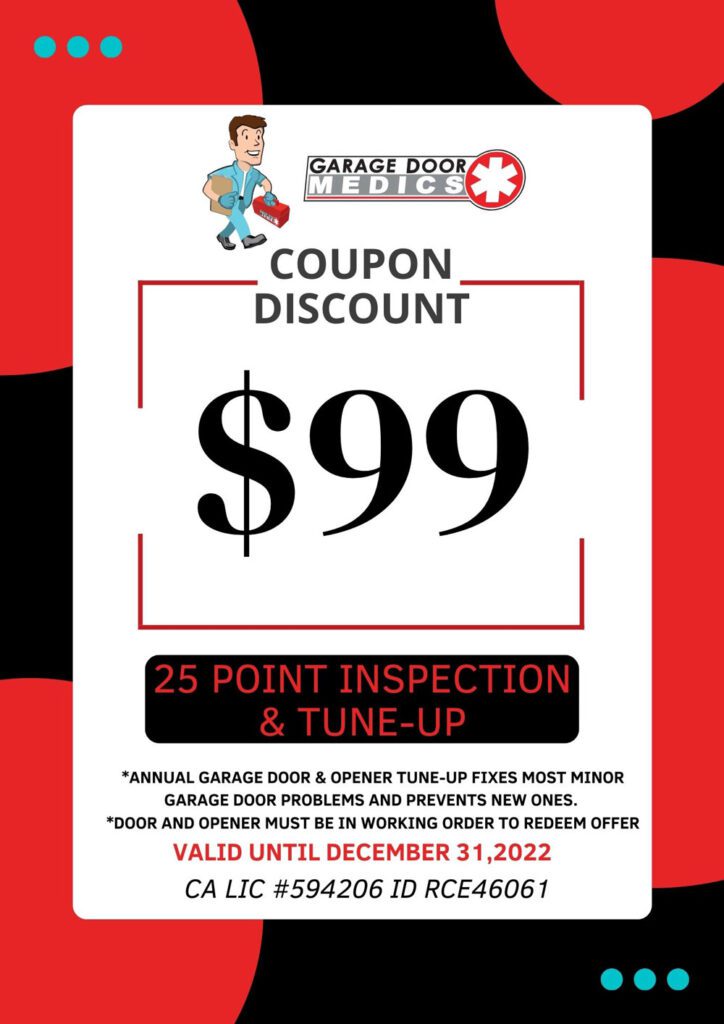A noisy garage door is not only annoying but also points to poorly functioning parts. Specifically, the noise indicates that the door’s metal parts rub against each other and cause friction. For that reason, lubricating the garage door is the best method for a quieter, well-running garage door.
Fortunately, learning how to lubricate your garage door is easy. You should lubricate your garage door once or twice a year for optimal maintenance. However, you should also note that noisy garage doors can indicate problems requiring professional repairs.
Is your garage door making loud, clunky noises? The experts at Garage Door Medics know how to take care of major and minor garage door issues. Read on for our proven tips and tricks to lubricating a garage door.
Is My Garage Door Stuck Because It Needs Lubrication?
Though garage doors occasionally get stuck because of poor lubrication, your door is most likely malfunctioning because of another problem. Sometimes, it’s as easy as removing a blockage on the tracks or floor. But misaligned or damaged tracks are a more severe issue that could cause malfunction.
If you think the problem is severe enough for a repair or replacement, contact garage door installers in Carlsbad. We will send an experienced garage door technician to check out the problem and explain the next steps.
Supplies You Will Need
To lubricate your garage door, you need the following supplies:
- Grease or lubricant: You should use a lithium-based door lubricant. This type of lubricant usually comes in a spray can. Silicone-based grease also works but do not use WD-40 as it can cause corrosion.
- Two old rags: A rag helps spread the grease on the top of the rail and the tracks.
- A vacuum, broom, or duster: You may need a vacuum or other cleaning tool to clear out areas with dust and debris. Certain parts of the garage tracks may be hard to access due to their narrowness, so a vacuum or broom could facilitate your cleaning.
Once you’ve gathered these supplies, you’re ready to lubricate the garage door.
5 Easy Steps to Lubricate the Garage Door
1. Close Your Garage and Cut the Electricity
If your garage has an automatic door, use the garage door opener to close it first. For manual garages, make sure the door is fully shut.
You must also cut the electricity to an automatic door to ensure there is no danger while you’re cleaning. You can either unplug the door from the power source or turn off its breaker in the circuit box.
2. Clean the Door Tracks
Sometimes excess debris in the garage door tracks can cause your door to squeak even more. Though you don’t need to lubricate them, cleaning your tracks keeps your garage door running smoothly. Wipe the tracks with a wet rag to clean them.
If there is particularly tough dirt stuck in the tracks, you can use an automotive brake cleaner to loosen it. You can also use your vacuum, broom, or duster to clean hard-to-reach crevices and the top of the tracks.
3. Apply Grease to All Moving Parts of the Garage Door
You need to lubricate all the following parts of the door:
- Garage door springs: Use a step ladder to look for the springs at the top of your garage door. You’ll usually find the springs in the middle of the top bar between the end bearing plates. Check that the springs are functional before lubricating them as a technician must repair damaged or bent springs immediately.
- Bearing plates: The end bearing plates are the metal plates on either side of the bar supporting the garage door spring. You should lubricate them and the wheels that jut up against them as that’s where the most friction occurs.
- Armbar: The armbar, aka the draw bar or opener, hangs from the ceiling bar that attaches to the motor. You should see the armbar in front of the spring and attached to the top of the garage door. You should coat the armbar in lubrication since it moves the entire garage door up and down.
- Top of the rail: You do not need to grease the entire rail. Rather, focus on the bar by the ceiling to which the armbar attaches. This rail holds the chain that moves the garage door, so you can use an old rag to work in the lubricant.
- Chain: The top rail also holds the chain, which comes with a protective coating on top. As such, you don’t need to grease the chain often because the coating already acts as lubrication. However, you should check your garage’s user manual to learn how to best care for the chain.
- Rollers: At this point, you can set the step ladder aside as you likely won’t need it anymore. Proceed to lubricate the rollers, which you will find attached to the curved track on either side of the door and the hinges. You should use a spray attachment to get the lubricant inside the rollers, then wipe any excess off with a rag (do not grease nylon rollers).
- Hinges: The hinges are the metal parts that control the movement between each slat of the garage door. Give every hinge one or two sprays where it connects to the track.
- Lock: Depending on your garage door, you may have a lock and lock bar attached to the middle slat. Grease the lock by using the same spray attachment to coat the inner keyhole. This lubrication will prevent the lock from seizing and rusting.
Make sure you’ve thoroughly lubricated all these garage door parts as any one of them could cause squeaking. Unlubricated parts also tend to wear down more quickly than well-lubricated parts. Therefore, learning how to lubricate your garage door properly will go a long way toward preventing expensive repairs.
4. Open and Close the Door to Spread the Grease
After lubricating all the garage door parts, you can reconnect the power source (if you have an electric door). Open and close the door several times to confirm that you’ve sufficiently coated all the components in grease.
5. Check That Your Door Works and Is Quieter
If you’ve lubricated all the parts properly and still have a noisy garage door, it’s time to call an expert. Any remaining squeaking means you have another problem with your garage door that a professional must fix.
If your garage door is no longer noisy, you should still check that you have no misalignment of the parts. For example, your garage door has two small black components at its bottom that serve as motion sensors. If these sensors are now misaligned, dirty, or out of place, your door will not open and shut properly.
Is Your Garage Door Still Malfunctioning? Call a Professional
A garage door that continues to malfunction after proper lubrication needs professional repair service. Many garage doors are at least several years old, so they are bound to break down at some point.
For honest and trustworthy garage door technicians in Carlsbad, CA, call Garage Door Medics. We have over 30 years of experience with garage doors and are available 24/7 for emergencies. We only recommend the repairs your garage door needs.
Call us at 888-997-2423 to set up a maintenance appointment today. If you’d like to learn more about topics like “how to lubricate a garage door,” visit our blog to learn more garage door maintenance tips.


